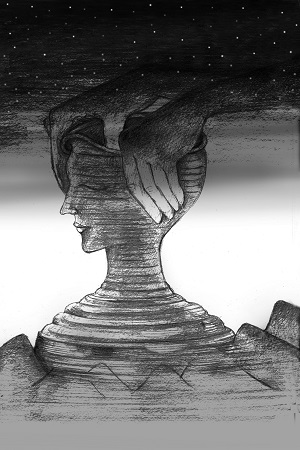Dec 13, 2025
Dec 13, 2025
Guru Kumhar Sikh Kumbh Hai, Gadh Gadh Kadhe Khot
Antar Hath Sahar De, Bahar Bahe Chot

Translation
Guru is the Potter, disciple is the (unbaked) pot
Gives Shape and cures the flaws with care
Protecting (always) with palm from inside
While pounding the pot from outside
 My Understanding
My Understanding
Kabir, in this Doha reveals the quality of a good teacher, the Guru.
In this example, the Potter identifies the raw clay or unbaked earthen pot with flaws and blemishes. Being a skilled artisan (the Potter), takes the clay (the raw material) and gives it the shape of a pot. To ensure that the final product (the Pot) is flawless and immaculate, the potter always has palm of his one hand inside the pot while the second hand keeps beating it from outside. This ensures that the pot does not shatter or break during the pottery process.
In this Doha, Kabir equates a disciple with clay or the unbaked earthen pot and the Guru as the Master Potter.
The Guru takes upon himself to instruct and educate the disciple who has the potential for enlightenment and realization. The "beatings" in this case are Guru's strict disciplinary actions enforced during the training and learning period. Compassion, patience, perseverance and Optra are what makes Guru's element of protection that protects the disciple during the various trials and tribulations that come in the path of learning and realization.
In our work-a-day life also, we can notice that good teachers are the ones who follow the rule of "OPTRA".
O in Optra stands for Object, the theme or the topic of education.
P in Optra stands for Preparation. The teacher must prepare himself thoroughly about the topic to be taught.
T in Optra stands for Transmission. The teacher must have the ability to transmit the knowledge, so as to bring home and register the true meanings to the students.
R in Optra stands for Reception. The teacher must be careful in gauging that what he is transmitting (educating) is being properly received by the students.
A in Optra stands for Assimilation. What good is the effort of the teacher, if the learning is not assimilated, adopted and amalgamated by the students?
Kabir, through his two liners (Dohas) which are based on similes and situations that surround our daily lives fully envelopes the Optra principle. Kabir's verses immediately touch our inner self, compel us to meditate on them and are totally relevant and helpful in guiding and regulating our lives, in both social and spiritual context.
July 5, 2011
Image (c) Gettyimages.com

|
Beautiful explanation of role of a teacher. |

|
Whenever I read Kabir's dohas, it gives a new light to life. great saint.. |

|
Amazing truth in this philosophy, since the days of Hindi poetry during my KV IIT Chennai days with Mr. Jamuna Rai our teacher then. Bless his heart wherever he is. |

|
Thank you for a very clear lesson about what a good Guru try to accomplish and the concept of Optra and its detailed meaning. Since I had no idea on the subject of Qptra your ability to explain it simple but exact detail certainly help me to understand. Thank you so much. |

|
Very well understood and interpreted. |

|
I am instructor a practical teacher in muslims a cast kumhar change their cast name ar-Rehman name of ALLAH and called REHMANI.. Was it is a good example ? |

|
When there is a great guru, a disciple automatically appears from nowhere: an Arjun for Lord Krishna or a Hanuman for Lord Rama. This is like 'lightning-and-thunder' combination!! Great doha of Kabir ji, and very well explained, Rajender ji. |

|
Your explaination is just AMAZING. it is very good. Thanks for putting perfect insight into the Great Kabir's dohas. |

|
Mr. Krishan, Namaste! You have captured the hart and soul of Kabirji's teachings and message for an individual as well as the humanity. Whenever I read or listen to Kabirji's bhajans or dohas and can not quite grasp the meaning or the essence, I have come to your website's door. Sir, allow me express my sincere appreciation and gratitude toward your effort to disseminate the true Kabirji. I believe your insight and understanding is so profoundly honest that it takes me to Kabirji charan. Will you be translating Kabirji's Bijak anytime soon? Thank you. Shashi Bhakta |

|
I wonder if Kabir has ever talked about 'supatra', the right and receptive student. Just as Aristotle needed an Alexander, Chanakya, a Vikramaditya, and Ramakrishna, a Vivekananda; every Guru needs a right student. A student also shapes and creates a Guru and not only the vice-versa. |